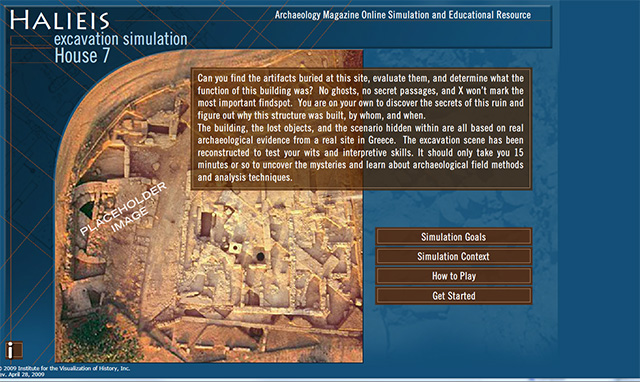 Learning Sites provided its modeling and programming expertise to the Institute for the Visualization of History for this archaeology simulation package. The project was initially suggested and would eventually be hosted by Archaeology Magazine. The goal was to create an online excavation simulation game using the actual data from House 7 at ancient Halieis, Greece (see the game's introduction screen at the left; hover over to enlarge). The project proceeded with the collaboration of Bradley Ault, University of Buffalo, who had then (2008) recently studied and published the houses from the site.
Learning Sites provided its modeling and programming expertise to the Institute for the Visualization of History for this archaeology simulation package. The project was initially suggested and would eventually be hosted by Archaeology Magazine. The goal was to create an online excavation simulation game using the actual data from House 7 at ancient Halieis, Greece (see the game's introduction screen at the left; hover over to enlarge). The project proceeded with the collaboration of Bradley Ault, University of Buffalo, who had then (2008) recently studied and published the houses from the site.
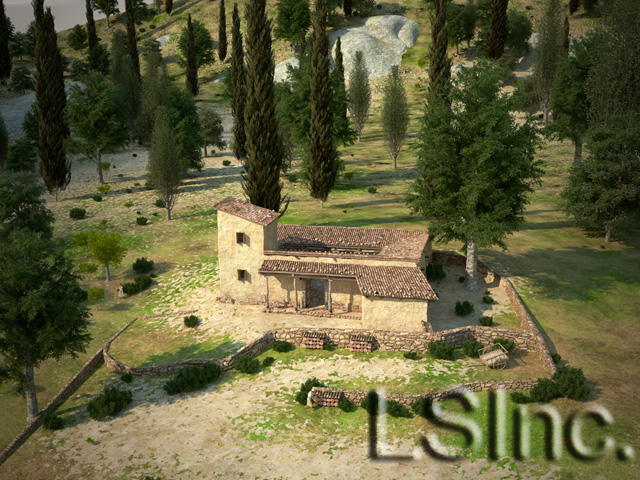 The team realized that such an online module based on House 7 could become an effective introduction to both archaeology and ancient Greek culture because of the house's rich and well-documented archaeological record. The online learning experience would eventually be complemented by links to the virtual reality reconstruction of an Attic farmhouse at Vari (that link will bring you our virtual reality recreation of the Vari House), roughly contemporaneous with House 7 (see an aerial view of the Vari house at the left; hover over to enlarge). The connection would have allowed comparison of life in urban and rural ancient Greek contexts. Among the longer-term goals of the project were to devise and offer a lesson plan to guide teachers and students in further explorations of ancient Greek domestic life, archaeology, and Hellenic culture (the project was never fully implemented).
The team realized that such an online module based on House 7 could become an effective introduction to both archaeology and ancient Greek culture because of the house's rich and well-documented archaeological record. The online learning experience would eventually be complemented by links to the virtual reality reconstruction of an Attic farmhouse at Vari (that link will bring you our virtual reality recreation of the Vari House), roughly contemporaneous with House 7 (see an aerial view of the Vari house at the left; hover over to enlarge). The connection would have allowed comparison of life in urban and rural ancient Greek contexts. Among the longer-term goals of the project were to devise and offer a lesson plan to guide teachers and students in further explorations of ancient Greek domestic life, archaeology, and Hellenic culture (the project was never fully implemented).
The pin points to the residential part of ancient Halieis.
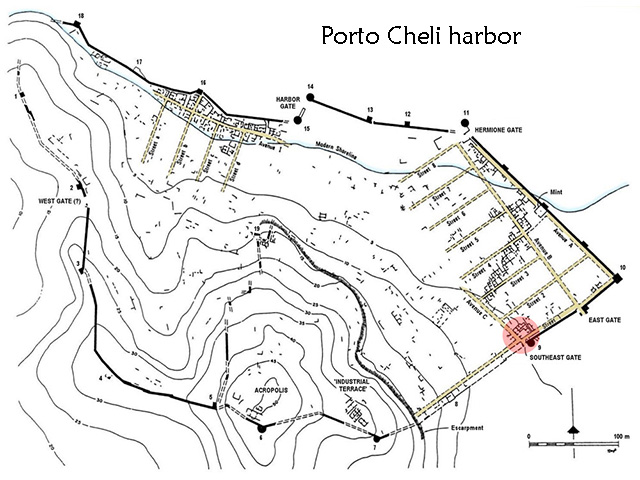 The ancient town of Halieis is located on the southern Argolid peninsula, Greece, across the harbor from the modern town of Porto Cheli (see the map above and the site plan at the left; House 7 is indicated by the red circle; hover over to enlarge). The part of the ancient settlement that we were interested in is dated from at least the 7th c. BCE until the site's abandonment in early 3rd c. BCE. The site flourished and expanded during the 4th century BCE. At its height, the city walls (nearly 2km long and containing nineteen towers and five gates) of this earliest-known ancient Greek planned city encompassed 18 hectares (c.45 acres) and included an acropolis and a gridded street network that might have contained as many as 500 houses, an industrial neighborhood, and a mint. The city also had a harbor and a major sanctuary to Apollo (both now underwater). Halieis was excavated by American teams, first under the direction of Michael Jameson, intermittently between 1962 and 1980 (the site is now mostly overgrown).
The ancient town of Halieis is located on the southern Argolid peninsula, Greece, across the harbor from the modern town of Porto Cheli (see the map above and the site plan at the left; House 7 is indicated by the red circle; hover over to enlarge). The part of the ancient settlement that we were interested in is dated from at least the 7th c. BCE until the site's abandonment in early 3rd c. BCE. The site flourished and expanded during the 4th century BCE. At its height, the city walls (nearly 2km long and containing nineteen towers and five gates) of this earliest-known ancient Greek planned city encompassed 18 hectares (c.45 acres) and included an acropolis and a gridded street network that might have contained as many as 500 houses, an industrial neighborhood, and a mint. The city also had a harbor and a major sanctuary to Apollo (both now underwater). Halieis was excavated by American teams, first under the direction of Michael Jameson, intermittently between 1962 and 1980 (the site is now mostly overgrown).
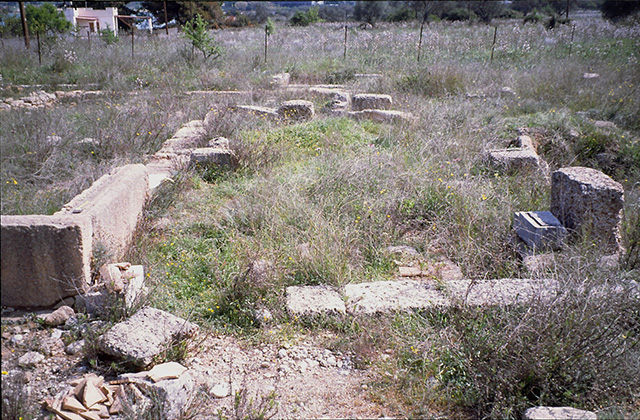 The simulation project focused only on House 7, situated at the intersection of Avenue C and Street 1 in the southeast corner of the lower town near the Southeast Gate, at the southwest corner of an insula of maybe ten houses (see the site plan above; at left a view northwest over the entryway, the prothyron, into House 7 as it looked in 1992; photo courtesy of Bradley Ault; hover over to enlarge). The house measures c.16 x 13m and is composed of about 11 spaces (with some being subdivided). Its entrance was off Avenue C through the prothyron (a shallow recessed space off the street) which led into an open courtyard off of which most of the other major rooms opened.
The simulation project focused only on House 7, situated at the intersection of Avenue C and Street 1 in the southeast corner of the lower town near the Southeast Gate, at the southwest corner of an insula of maybe ten houses (see the site plan above; at left a view northwest over the entryway, the prothyron, into House 7 as it looked in 1992; photo courtesy of Bradley Ault; hover over to enlarge). The house measures c.16 x 13m and is composed of about 11 spaces (with some being subdivided). Its entrance was off Avenue C through the prothyron (a shallow recessed space off the street) which led into an open courtyard off of which most of the other major rooms opened.
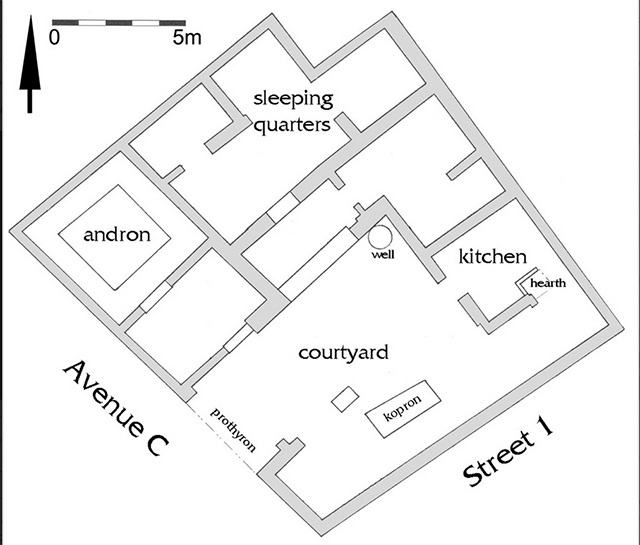 House 7 is typical of the 4th-century dwellings at Halieis. It had its own well, major hearth, a kopron (refuse pit for composting), an andron (men's diningroom), kitchen, storage areas, and sleeping quarters (in one of those rooms was found a small circle of pebbles, perhaps for playing kuncklebones; see the plan at the left; hover over to enlarge). Evidence demonstrates that part of the house had a second floor. A full range of domestic artifacts was uncovered with the house, including pottery and metal goods.
House 7 is typical of the 4th-century dwellings at Halieis. It had its own well, major hearth, a kopron (refuse pit for composting), an andron (men's diningroom), kitchen, storage areas, and sleeping quarters (in one of those rooms was found a small circle of pebbles, perhaps for playing kuncklebones; see the plan at the left; hover over to enlarge). Evidence demonstrates that part of the house had a second floor. A full range of domestic artifacts was uncovered with the house, including pottery and metal goods.
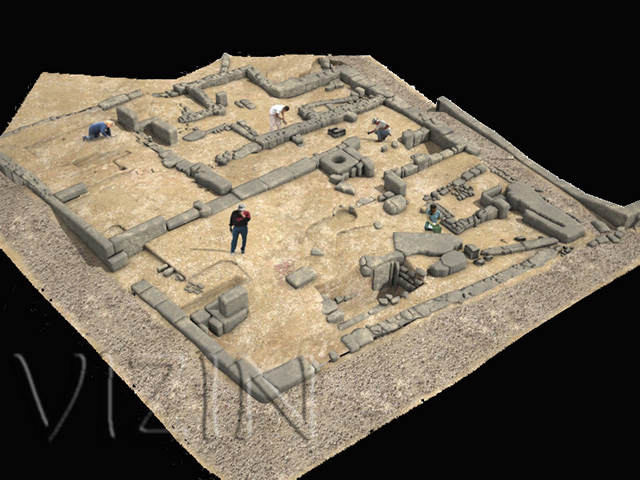 We began by building a computer model of the house as it looked after it was fully excavated (see the results at the left; hover over to enlarge). Next, we modeled its most important artifacts, which we then put back into the house model at the locations where they were found (to be rediscovered during the excavation simulation).
We began by building a computer model of the house as it looked after it was fully excavated (see the results at the left; hover over to enlarge). Next, we modeled its most important artifacts, which we then put back into the house model at the locations where they were found (to be rediscovered during the excavation simulation).
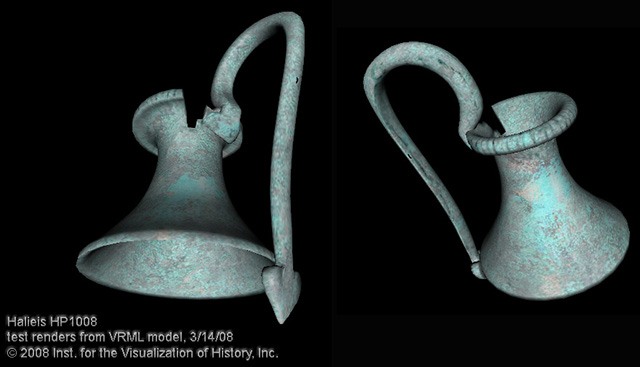 Most of the objects found in the house were fragmentary, but a few were nearly complete. By including a range of artifacts in the final model, the player would have been able to determine the function of spaces and thus of the entire structure. Some of the modeled objects (built based on the excavation drawings, photographs, and descriptions) are shown at the left here and below (to the left is a small bronze vessel neck [about 5cm tall] and handle found in the corridor between the courtyard and sleeping quarters; hover over to enlarge).
Most of the objects found in the house were fragmentary, but a few were nearly complete. By including a range of artifacts in the final model, the player would have been able to determine the function of spaces and thus of the entire structure. Some of the modeled objects (built based on the excavation drawings, photographs, and descriptions) are shown at the left here and below (to the left is a small bronze vessel neck [about 5cm tall] and handle found in the corridor between the courtyard and sleeping quarters; hover over to enlarge).
At the left is a virtual reality model of a small stemless bowl with handles (c.9cm in diameter at the rim), found in the room between the courtyard and the andron (see the plan above).
Bowl 2540 -- simply left click and use your mouse or touchpad to rotate and zoom in on the model; use the arrow keys or the w, a, s, d keys to pan.
At the left is a virtual reality model of a small shallow bowl (c.9cm in diameter at the rim), found near the bowl above in the room between the courtyard and the andron (see the plan above).
Bowl 2538 -- simply left click and use your mouse or touchpad to rotate and zoom in on the model; use the arrow keys or the w, a, s, d keys to pan.
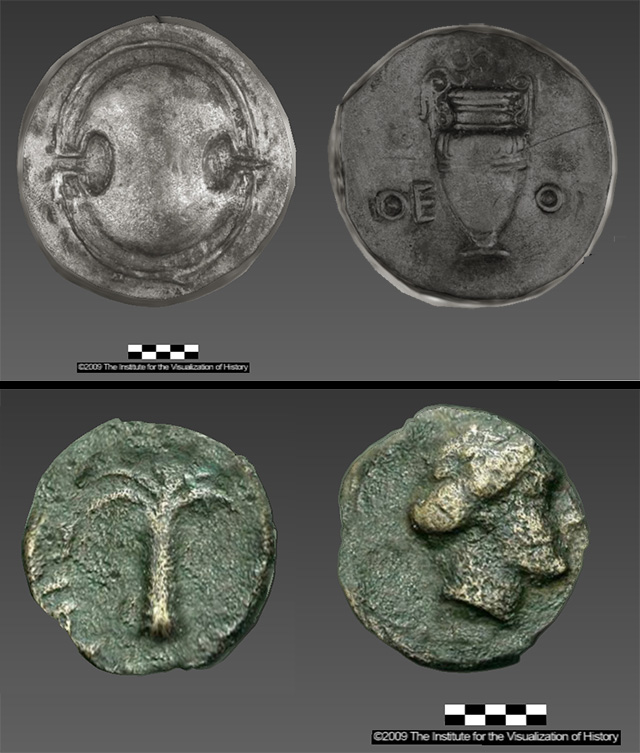 Several coins were also found in the house, two renders from their virtual reality models are at the left (hover over to enlarge). The upper coin is a Theban silver stater (found in the sleeping quarters); and the lower example is a bronze coin probably from Tiryns (found in the northern section of the courtyard).
Several coins were also found in the house, two renders from their virtual reality models are at the left (hover over to enlarge). The upper coin is a Theban silver stater (found in the sleeping quarters); and the lower example is a bronze coin probably from Tiryns (found in the northern section of the courtyard).
As the modeling of the as-excavated house and its objects neared completion, and in preparation for programming the game, we created a dramatic locational video to show players the house's context.
click below to play the Halieis video
 The final excavation simulation game had few general specifications: it should be based on the reality of the Halieis excavations, with actual objects from the House 7 dig; it should be useful and fun for anyone from 6th-graders with an introduction to the ancient world up through college-age players with more advanced knowledge of Greek history; and the game shouldn't take more than about 15 minutes to complete. As the sim developed, so did the specific functionality of the gameplay and the sequence of features. The completed online package was to teach about archaeological field methods, field strategies and choices, how to use artifact contexts and circulation patterns to deduce spatial function, and ancient Greek culture in an exciting and engaging interactive environment (see the sim's homepage at the left; hover over to enlarge).
The final excavation simulation game had few general specifications: it should be based on the reality of the Halieis excavations, with actual objects from the House 7 dig; it should be useful and fun for anyone from 6th-graders with an introduction to the ancient world up through college-age players with more advanced knowledge of Greek history; and the game shouldn't take more than about 15 minutes to complete. As the sim developed, so did the specific functionality of the gameplay and the sequence of features. The completed online package was to teach about archaeological field methods, field strategies and choices, how to use artifact contexts and circulation patterns to deduce spatial function, and ancient Greek culture in an exciting and engaging interactive environment (see the sim's homepage at the left; hover over to enlarge).
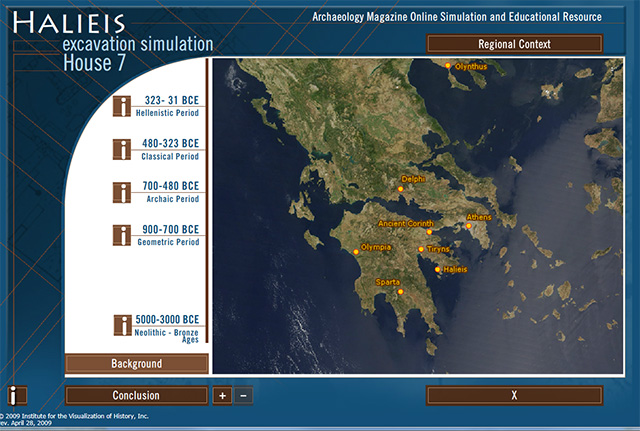 Several of the main game screens can be seen here. At the left (hover over to enlarge) is the Regional Context screen, which shows a map of Greece with major sites indicated and a timeline at the left side of the screen. This introductory screen had many interactive features, for example: each segment of the timeline was a clickable link to historical information about the period and specific events that affected Halieis; the map was zoomable all the way down to a plan of House 7; and once a player reached the house plan, there was a button that triggered the interactive excavation portion of the game.
Several of the main game screens can be seen here. At the left (hover over to enlarge) is the Regional Context screen, which shows a map of Greece with major sites indicated and a timeline at the left side of the screen. This introductory screen had many interactive features, for example: each segment of the timeline was a clickable link to historical information about the period and specific events that affected Halieis; the map was zoomable all the way down to a plan of House 7; and once a player reached the house plan, there was a button that triggered the interactive excavation portion of the game.
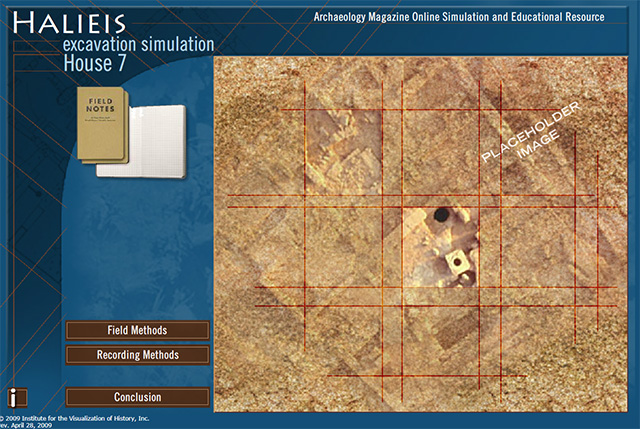 The goal of the game was a search for the function of the rooms, based on artifacts excavated in each space (the main digging screen is shown at the left; hover over to enlarge). Two buttons led to background resources about excavation techniques and documentation methods. To dig, players simply clicked in the gridded squares; each click dug deeper down into that square simulating an excavation, eventually revealing architectural features and artifacts that together helped identify the function of each space.
The goal of the game was a search for the function of the rooms, based on artifacts excavated in each space (the main digging screen is shown at the left; hover over to enlarge). Two buttons led to background resources about excavation techniques and documentation methods. To dig, players simply clicked in the gridded squares; each click dug deeper down into that square simulating an excavation, eventually revealing architectural features and artifacts that together helped identify the function of each space.
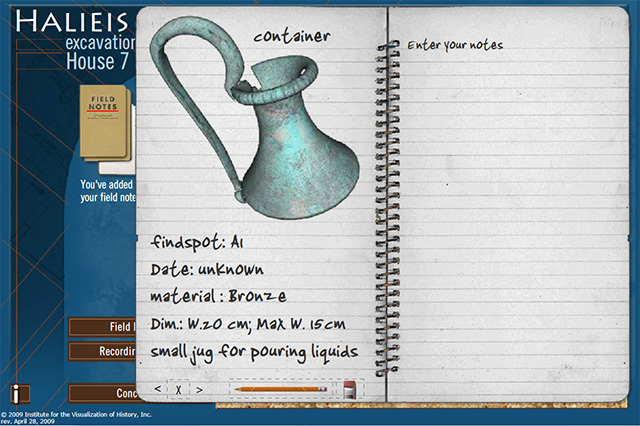 Once an artifact is found, and the player clicks on the object to remove it from the dig, it is automatically added to the field notebook (see the notebook screen at the left; hover over to enlarge). An interactive, virtual reality 3D model of the object is added along with all relevant inventory information, including material, findspot, and dimensions. Other interactive features of this page include: a pencil for adding personal notes about the object or its findspot; an eraser to change added notes; and icons for flipping pages in the notebook or closing it and returning to the dig. At any time during the dig, a player can posit a conclusion regarding the spaces of the house and "publish" them for the game to evaluate.
Once an artifact is found, and the player clicks on the object to remove it from the dig, it is automatically added to the field notebook (see the notebook screen at the left; hover over to enlarge). An interactive, virtual reality 3D model of the object is added along with all relevant inventory information, including material, findspot, and dimensions. Other interactive features of this page include: a pencil for adding personal notes about the object or its findspot; an eraser to change added notes; and icons for flipping pages in the notebook or closing it and returning to the dig. At any time during the dig, a player can posit a conclusion regarding the spaces of the house and "publish" them for the game to evaluate.
Many more exciting features were planned, such as: random events to affect how the simulation unfolds; a randomizer to change some artifact locations so the game would have been slightly different each time played; intelligent conclusions and suggested follow ups would guide users (e.g., "you have found so and so, but your conclusions are not valid, go back and try...."); the notebook would have allowed users to create their own drawings of features and finds; the ability to hire (e.g., pottery or metal) experts before leaving for the site to help analyze finds; and the ability to select different tools and equipment before starting the dig with excavation depth and speed dependent on which tools were used.
If you are interested in seeing these (or similar) innovative teaching tools come to fruition, please contact us with your ideas.
Ault, Bradley A.
2005 The Excavations at Ancient Halieis, vol. 2, The Houses: the organization and use of domestic space. Bloomington, IN: Indiana University Press.
McAllister, Marian Holland (with contributions by Michael H. Jameson, James A. Dengate, and Frederick A. Cooper)
2005 The Excavations at Ancient Halieis, vol. 1, The Fortifications and Adjacent Structures,. Bloomington, IN: Indiana University Press.